批评6.女性主义
女性主义艺术批评

女性主义艺术批评当谈到女性主义艺术批评时,我们不得不追溯到20世纪60年代末期,当女性主义运动开始在西方国家崭露头角。
在此期间,许多女性艺术家和批评家开始对传统艺术界的男性主导地位提出质疑,并努力为女性艺术家争取更多和认可。
从那时起,女性主义艺术批评逐渐发展成为一种独立且非常重要的批评方法,对艺术界产生了深远影响。
关键词:女性主义,艺术批评,男权,女权,身份认同一、女性主义艺术批评的背景女性主义艺术批评的出现,是对于历史上以男性为中心的艺术界的回应。
在西方艺术史中,女性艺术家往往处于边缘地位,作品常常被忽视或被男性艺术家的光芒所掩盖。
女性主义艺术批评家则强调对女性艺术家及其作品的,以及挑战男性中心的艺术观念和体制。
二、女性主义艺术批评的核心观点1、强调性别平等女性主义艺术批评的核心观点是强调性别平等。
它认为男性和女性应该在艺术创作和批评中享有同等的权利和机会,不应该因为性别而受到歧视或排斥。
2、重新审视传统艺术价值观念女性主义艺术批评对传统的艺术价值观念提出质疑,认为这些观念往往是以男性为中心的。
它主张重新审视和评价女性艺术家的作品,以及挑战和改变传统的艺术标准。
3、女性艺术家和被忽视的艺术形式女性主义艺术批评女性艺术家的创作,以及被忽视的艺术形式和主题。
它努力为女性艺术家争取更多的认可和,同时也拓展了我们对艺术的理解和欣赏范围。
三、女性主义艺术批评的实践举例1、琳达·诺克林的艺术批评琳达·诺克林是20世纪70年代美国女性主义艺术批评的代表人物之一。
她的文章《为什么没有伟大的女性艺术家?》对传统的艺术史进行了深刻的反思。
她指出,由于男性中心的艺术体制和价值观念,女性艺术家往往被边缘化或忽视,导致她们的作品无法得到应有的认可。
2、玛莉莲·芭芭拉的艺术实践玛莉莲·芭芭拉是一位美国女性艺术家,她的作品以挑战传统的艺术观念和体制而闻名。
她的作品涉及到性别、身份认同和权力等问题,通过自我表达和反思来探索女性的地位和权利。
女性主义批评
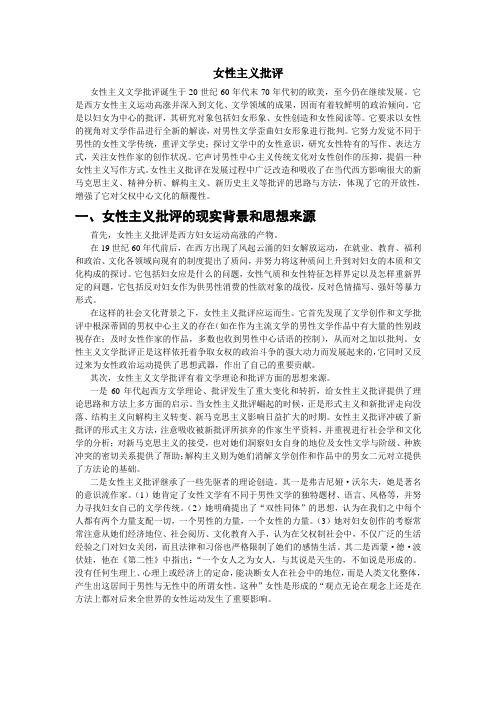
女性主义批评女性主义文学批评诞生于20世纪60年代末70年代初的欧美,至今仍在继续发展。
它是西方女性主义运动高涨并深入到文化、文学领域的成果,因而有着较鲜明的政治倾向。
它是以妇女为中心的批评,其研究对象包括妇女形象、女性创造和女性阅读等。
它要求以女性的视角对文学作品进行全新的解读,对男性文学歪曲妇女形象进行批判。
它努力发觉不同于男性的女性文学传统,重评文学史;探讨文学中的女性意识,研究女性特有的写作、表达方式,关注女性作家的创作状况。
它声讨男性中心主义传统文化对女性创作的压抑,提倡一种女性主义写作方式。
女性主义批评在发展过程中广泛改造和吸收了在当代西方影响很大的新马克思主义、精神分析、解构主义、新历史主义等批评的思路与方法,体现了它的开放性,增强了它对父权中心文化的颠覆性。
一、女性主义批评的现实背景和思想来源首先,女性主义批评是西方妇女运动高涨的产物。
在19世纪60年代前后,在西方出现了风起云涌的妇女解放运动,在就业、教育、福利和政治、文化各领域向现有的制度提出了质问,并努力将这种质问上升到对妇女的本质和文化构成的探讨。
它包括妇女应是什么的问题,女性气质和女性特征怎样界定以及怎样重新界定的问题,它包括反对妇女作为供男性消费的性欲对象的战役,反对色情描写、强奸等暴力形式。
在这样的社会文化背景之下,女性主义批评应运而生。
它首先发现了文学创作和文学批评中根深蒂固的男权中心主义的存在(如在作为主流文学的男性文学作品中有大量的性别歧视存在;及时女性作家的作品,多数也收到男性中心话语的控制),从而对之加以批判。
女性主义文学批评正是这样依托着争取女权的政治斗争的强大动力而发展起来的,它同时又反过来为女性政治运动提供了思想武器,作出了自己的重要贡献。
其次,女性主义文学批评有着文学理论和批评方面的思想来源。
一是60年代起西方文学理论、批评发生了重大变化和转折,给女性主义批评提供了理论思路和方法上多方面的启示。
当女性主义批评崛起的时候,正是形式主义和新批评走向没落、结构主义向解构主义转变、新马克思主义影响日益扩大的时期。
课件-文学批评--女性主义批评
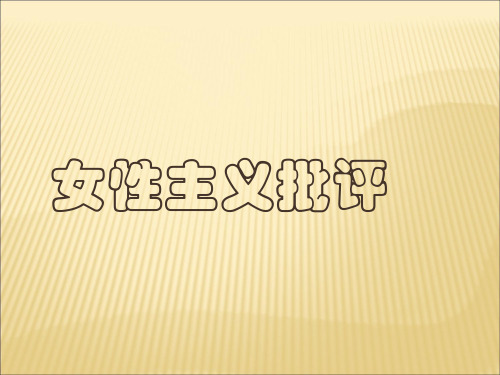
重新评价男性笔下的女性形象
西方传统文化中的女性原 型——夏娃与圣母
在女性主义批评者看来,在传 统文学作品中特别是男性作家 的作品中存在着两个基本的女 性原型:其一是圣母型或天使 型,集美丽、高贵、温柔、可 爱于一身,贞洁温驯、恬静安 宁、富有母性,是童贞女与母 亲这两类男性最渴求的女性形 象的整合。
理论先驱之二:西蒙·波伏娃
《第二性》(1949年)
此书被誉为“有史以来讨论妇女的最健全、最 理智、最充满智慧的一本书“,甚至被尊为西 方妇女的“圣经”。它以涵盖哲学、历史、文 学、生物学、古代神话和风俗的文化内容为背 景,纵论了从原始社会到现代社会的历史演变 中,妇女的处境、地位和权利的实际情况,探 讨了女性个体发展史所显示的性别差异。《第 二性》实可堪称为一部俯瞰整个女性世界的百 科全书,她揭开了妇女文化运动向久远的性别 歧视开战的序幕。
第三,在(废都)中,作者笔下的 女性基本上可以说没有属于自己的 社会身份,她们所扮演的社会角色 只是男性的附属物。从牛月清到唐 宛儿再到柳月、阿灿没有一位女性 有一份正经的工作,她们也没想到 要为自己的社会工作而奋斗。牛月 清想到的是当好“庄夫人”,唐宛 儿、柳月想到的是争到“庄夫人” 这一头衔。贾平凹抱着一种狭隘保 守的两性观来描写女性,其笔下的 女性已为男权所异化,她们自觉的 按照父权制文化对女性的标准去思 考,去行动,她们没有自己的思想, 没有属于自己的语言!
(一)女性主义批评(女性的阅读)
女性主义批评是一种以女性作为读者的批 评,分析过往一切由男性创造的文学文本。 它的课题包括妇女在文学作品中的形象、文 学批评中对妇女的忽视和歪曲,以及男性构 建的文学史的种种疏漏。她们试图打破男性 中心主义的研究视角,从女性视角来重新审 视文学作品和文学史,从而对文学现象作出 新的阐释。
女性主义

义,含有侧重争取男女之间文化与精神平等的意 思。
导论
❖ 女性主义批评首先是一种以妇女为中心的批 评。其次,批评在这里有两方面的含义:其 一:具有纯粹的文本批评意义,即通过对具 体的文本的研究,揭示出其中隐含的性别歧 视和女性意识的内容;其二:具有社会批评 的意义,即通过对文本内容的研究,批评不 平等的社会现实。
经济制度。父权制社会对女性的压迫是建立在男 权文化的基础上的,主要支柱是“性政治” (三)个人的就是政治的
高度重视存在于个人领域的性别压迫 (四)男性气质与女性气质的融合
提出建立一个双性一体(androgoynous)的 平等社会,试图消除男性和女性的社会性别差异,
以此来消除性别歧视。
评价
❖ 激进的女权主义以一种新的社会视角来解释 社会现实,在一定程度上改变了传统理论, 对后世有很大影响。它是女权主义流派中唯 一一个将矛头指向男性的理论。但由于过于 关注女人本身,忽略了对妇女受压迫的社会、 历史、经济层面的分析批判,强调男女对立 的一面,没看到男女的同一性。
❖ 第一阶段:要求在父权制社会中获得同男人 平等的权利。
❖ 第二阶段:差异派女性主义,强调性别的差 异和女性的独特性,颂扬女性本质,并以差 异为名否认男性秩序。
❖ 第三阶段:拒绝形而上学的男女二分法,提 倡三个阶段的女性主义方法相互融合或同存 于同一个历史时间之内。注意女权、女性、 女人的统一。
女性主义派别
(3)从追求同样的平等向从差异性中追求平等转变。
评价
优点:促进妇女的觉醒,推动妇女的发展,激励广 大妇女为获得男女平等的权利而斗争,为之后的 女权主义的发展奠定了思想基础。
女性主义批评

第二阶段是1968年以后出现的新一代女权主义者, 即强调“女性”的女权主义者。她们一反初期注重 “平等”的策略,改弦更张,强调性别差异和女性 的独特性,注重女性不同于男性的心理体验、象征 表达和内在情思。
3
进入20世纪80年代,出现了第三代女权主义,即将 “女权”、“女性”加以整合折衷的重“女人”的女 权主义。不再提倡男女的对立或女性一元论,而是注 重多元论,提倡男女文化话语互补,即女人成为女人, 男人成为男人,在充分尊重男女独立人格的基础上扬 弃传统文化的弊端和偏见,完善和发展健康的人性。
一、定义
女性主义批评,是一种用女性意识观 照文学作品,具有女性价值标准和审美追 求的文学批评。
1
二、女权主义运动史
19世纪中叶到20世纪50、60年代西方掀起的大规模 妇女解放运动,是女权运动的第一个阶段,斗争矛 头是指向政治、经济、社会领域的,以争取政治平 等、经济平等、职业平等以及精神解放为主要目的。
女权主义批评认为,现存的社会结构是建立在父权制 基础上的,男性掌握着社会的基本功能,女性则被置 于社会配角的地位。女性要获得真正的解放,就必须 颠覆父权制的社会结构,揭露所有话语中潜藏的若隐 若现的“性歧视”。
9
(1)批判象征父权制社会秩序的符号体系
例如: 在英语中 female (女性)和 woman(女 人)的构成依赖于男性的male和man,是他们的派 生词,如同《圣经》中女性是由男性的一根肋骨 创造。
(法)波伏娃:《第二性》,中国书籍出版社, 200性》,被誉为西方 女权主义的“圣经”。她 认为西方社会是由男性控 制的家族式社会,女性是 社会中的第二性,处于附 属地位。同时,她还系统 清算了男作家作品中所虚 构的“女人神话”,批评 他们对女性形象的歪曲和 误解。
女性主义批评

女性主义批评
• 一、女权主义批评的背景和思想来源 • 二、英美派的女性主义批评 • 三、法国派的女性主义批评 • 四、批评与实践
一、女性主义批评的背景和思想来 源
• 19世纪后半叶开始的西方妇女解放运动—
—英美妇女获得选举权 • 60年代第二次女权运动——妇女的本质和 文化构成的探讨 • “它包括一名妇女应是什么的真正问题, 我们的女性气质和特征怎样确定、以及我 们怎样重新界定的问题。”
•
• “女人腔”是指与男性理性化语言相对立的
一种非理性的女性话语方式。“人们说她 是神经质的,不可理解的,惶惑不安的, 满脑子奇思怪想的,更不用提她的语言, ‘她’说起话来没有中心,‘他’也难以 从中分辨出任何连贯的意义。”但这种非 理性的女性话语方式又有一种包容二元对 立的特征。因为,“一个人不能从另一个 中分开,我/你,我们总是复合在一起,这 怎么会出现一个统治另一个的情况呢?”
• 露丝伊瑞格瑞 • “女性谱系”:“无论男性还是女性,人
类的身体已经被符码化地置于社会网络之 中,在文化中,并且被文化赋予意义,男 性被认为是雄健和有阳具(指创造力), 女性则是被动的和被阉割的。这不是生物 学的结论,而是身体的社会和心理学意 义。”
• 《他看女人的反射镜》:整个西方哲学都是一种
理性主义传统,在其中,女性被定一位非理性, 一种需要和应当被超越的他者,一个被阉割得不 完整的男人。 “女性谱系”,就是要回到“前俄狄浦斯”阶段, 那时的母亲是无性别之分的,而女儿也是对双性 同体的母亲认同的。目的要恢复一种新型的母女 认同关系。在这种女性谱系中,女性之间的关系 上升为主体与主体间的关系,女性不再沦为单纯 的客体。
女性主义批评
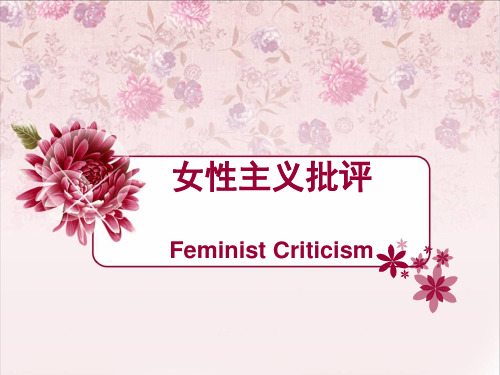
• 人们习惯将男性与强壮、主动化等号,而将女性与弱小、被动相提并论。艾尔 曼将这种习惯称为“性别类比的思维习惯”。文艺批评中的“大男子主义批评” 由此衍生出来。以男性的眼光和标准去阅读、批评,即使文艺批评中的性别歧 视。
4、“身份”批评阶段:80年代以后
• 崛起于70年代末的黑人女性主义批评启发了各少数族裔的女性主义者, 她们分别将本民族的妇女文学置于中心位置,考察种族和社会性别在 双重文化、种族交往中的作用。“身份”批评认为,种族区别和社会 性别区别一样,是后天人为的,不是生理的,实质是文化和社会的建 造。
• 芭芭拉•史密斯是少数族裔女性主义批评的先驱。她在《论黑人女性 主义文艺批评》中提出,以往的文艺批评均忽略了黑人妇女作家,她 的理论构想解开了“身份”批评之先,将种族引入女性主义批评乃至 整个文艺批评领域。这种对于种族和民族关系的研究,衍生出“后殖 民主义”的理论,这一理论将“身份”批评推向新的高潮。
•女性主义研究的对象:
妇女的创作、作品中的女性形象 在我国,我们既可以对中国女性作家的创作加以批评,如王安忆、
陈染、铁凝等的带有明显的女性意识的文本;也可以对男性作家笔 下的女性形象加以评析,如贾平凹的《废都》、苏童的《妻妾成群》 都有大量的女性形象。 许多男性的女性主义批评家也加入到这个队伍中来。
2、露西•依利加芮,代表作《镜子》,一方面运用马克思主义理论, 将妇女受压怕的根源归结为父权的社会制度;另一方面,在德里达 ((Derrida,1930—2004)当代法国哲学家、符号学家、文艺理论家和美学家, 解构主义思潮创始人。 )多元理论的启发下充分挖掘妇女间的区别。
女性主义批评

女性主义批评女性主义是70年代推动西方电影研究兴起的最重要的社会运动和文化批评话语之一。
反过来,电影研究在当时作为一个相对年轻和政治化的领域则为女性主义理论提供了肥沃的土地,使其能在学术领域里扎下根。
从这样一个结合中成长起来的女性主义电影研究一方面在有关表象、观众、和性差异的理论辩论中是高度专业化的;一方面在文化的涉及面和影响又是非常广泛的。
它同时介入了批评和文化生产两个方面。
作为一种批评方法论,女性主义在所有的知识形式和质询领域内都提出了有关性别和性别等级的重要观念。
女性形象一直是电影和有关视觉媒体的中心特征。
在电影批评和理论中,性别问题成为分析中心的思路彻底改变了传统的对女性形象、女性制作者、和女性观众的理解,并要求重新确定电影研究的规则。
女性主义电影批评的主要贡献是把性别问题引进了以前无视性别的“机器理论”和精神分析等批评方法,从女性主义的角度关注和分析在影视文本中性别的建构。
性别被看作是文化的、而不是生物学的术语,并界定为通常联系或看作特别适于男性或女性的那些角色、属性、和活动的社会观念。
通过考察各种策略,如语言、人物、布景、叙事结构、摄影机的工作、笑声频道、和音乐声道,性别的意识形态批评家评价影视文本如何保持或破坏现存的关于男性和女性的文化观念。
这些批评家还进一步考察一种和现存观念不同性别观念的建构,并讨论性别对待方式的社会和意识形态含义。
性别的意识形态批评家在词汇和概念上受符号学、心理分析、语言学、社会学、和电影研究的影响。
在性别的意识形态批评中使用的关键概念包括:性别化的主体,窥淫癖、恋物癖、女性的、男性的、性别、以及程式化的性角色、父权制、发音、以及法规等。
性别的意识形态批评家会提出以下问题:观众被摄影机角度、剪辑、情节等暗示来认同的是什么样的视点、感情、和经验?女性是被表现为窥淫癖快感的对象(从男性的视点被作为一个性对象加以展示)吗?男人被表现为窥淫癖快感的对象吗?这种视点是通过什么形式的和技术的策略传达的?对男人或女人、或两者,什么属性和态度被表现为是适当的?角色、价值、和情节是否保持或重建了关于性别的主流文化观念吗?如果存在话,文本鼓励何种对立的读解?女性主义的分类:社会主义女性,马克思主义女性,激进主义女性各种形式的女性主义女性主义这个词会让人觉得这是单独的一个意识形态,然而事实上女性主义存在有许多流派。
当代女性主义文学批评

当代女性主义文学批评第一部分阅读与写作:在《作为妇女的阅读》中,乔纳森·卡勒援引《卡斯特桥市长》说明作家在写作时呼唤的理想读者是有性别的。
女性主义者认为,女性经验将使她们评价作品时表现出与男性同行不同的选择,男性同行把妇女遇到的独特问题只当做一种有限的兴趣。
以《黄色糊墙纸》与《陷坑与钟摆》的对比为例,女性批评家试图证明重新挖掘出的女作家作品在文学价值上也不输于男作家,而不仅仅只是提出一个“有趣的问题”。
妇女经验是她们作为读者对作品进行权威性评价的一种渊源——重新估价被忽视作品。
卡勒总结的女性主义批评的三个时期:第一时期主要关注妇女经验与其读者经验的连续性,于是批评兴趣在于对女性人物的处境和心理的研究上,放在了一个作家、一种哦能够流派以及一个时期的作品中对妇女或女性形象的态度的研究上。
——有力的对控制文学作品的男性中心主义的批评。
比如波伏娃《第二性》以及凯特米利特《性别政治》,第二时期重心转向拷问妇女为什么总不能作为女人去阅读?女性主体与经验的分离性问题。
“作为女性的阅读”的基础或者判断的经验在哪儿?问题恰恰在于,女人们一直没有作为女人去阅读。
女人被引导去认同男性人物,去反对她们自己作为女性的利益。
比如小说《永别了,武器》女主角的死免去了男主角的负担,而男人的生命才是最珍贵的,我们的眼泪为男主角而流,并体验这种理想女性形象的寓意——唯一的一个好女人只是一个死去的人。
读者必须接受作者的男性视角才能欣赏结尾时的那种悲怆之情。
于是,女性主义批评的一个行为就是:从一个赞同型读者变成一个反抗型读者,通过这种拒绝赞同的行为,开始把根植于我们心中的男性意识去除掉。
女性主义批评,是一种对“菲勒斯批评”的批评。
女性主义批评对男性批评的批评越令人信服,它就愈能提供一种更宽泛和更综合的洞见,以分析和确定男性批评家有限和带偏见的阐释。
第二个阶段的女性主义批评力图证明自身比省略与歪曲的男性阅读更理性、更严肃、更具反省意识。
女性主义文学批评

女性主义文学批评
女性主义文学批评,是指在文学批评中以“女性主义”为主要立场与角度的批评。
“feminism” ,汉译原为女权主义,后又译作女性主义,究其原因,倒不在于前者那个“权”字有过于剑拔驽张的色彩(女性争取平等的就业权、教育权、选举权本就是合情合理之举) ,而在于社会对于女性的压迫,并不只体现在外在显见的不合理的制度方面,更在于一系列隐蔽内在的对女性的文化形塑与规训。
这就是通过各式各样的语言、符号与文化体系,男性社会制造出不可能威胁父权秩序与权威、侵犯他们的权力与利益、符合他们理想与标准的“女性” 。
女性主义批评
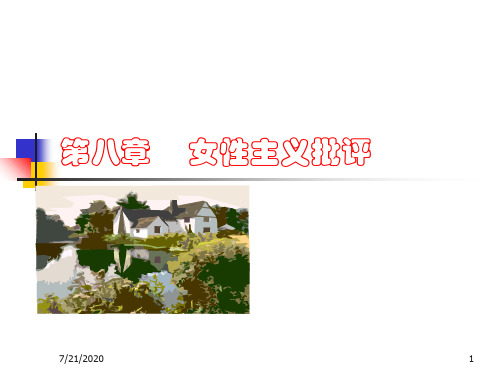
7/21/2020
9
二、思想先驱
女性主义文学批评理论体系的发展是对先辈思想理论继 承的结果。女性主义有两个当之无愧的理论先驱者,她们 是20世纪前半期对世界文坛和批评界产生重大影响的英国 的弗吉尼亚·伍尔夫和法国的西蒙·德·波伏娃,这两位批评 家无论从思想观念还是批评实践方面,都为女性主义文学 批评开拓了方向。
论妇女的生存状况,后被奉为“女权主义的宝典”。该书上卷
深入探讨了女性的生活、地位和种种神话,下卷主要说明当代
妇女从少到老的实际生活经历,研究她们的共同身心状况与生
存处境,提出:“一个女人之为女人,与其说是‘天生’的,不
如说是‘形成’的。女性意识的一部意义重大、对后世具有深
远影响的著作。波伏娃在她的这部理论著作中解构了女人之所
中,不仅广泛的生活经验之门对妇女关闭,而且法律和习俗 也严格限制了她们的感情生活,这是妇女创作难以发展的根 本原因。这种社会学批评,既抨击了男权中心社会对妇女创
作的压制,又在方法论上直.接启发了当代女权主义批评。
7/21/2020
11
(二)波伏娃
西蒙·德·波娃出版于1949年的著作《第二性》,主要讨
流话语下的社会传统观念和习俗,它渗透于人类生活的各个方
面,尤其是在对女人的社会定位上融入了父权专制和性政治的
思想,强调性别特征的非自然化和非稳定化。
7/21/2020
12
所以,波伏娃认为,女性成长的过程即是被社会观念和习 俗规定、束缚的过程,女性从一出生便被约定如何梳妆打 扮,如何穿衣,如何与别人交往,如此等等,女性的自然 天性被压抑形成了男权话语下的女性角色,被社会局限于 家庭和生育的狭隘天地里。社会强加于女性的观念和思想, 又反过来促使女性按照男性化社会的要求约束、改变自己, 去适应这个压抑自己的社会为她制定的价值取向。同时, 男权社会剥夺了女性的经济地位和话语权,使女性不得不 依赖于男性,为了生存她们去适应男性的一切爱好和习惯, 成为男性把玩和欣赏的对象,放弃了作为人的独立自主性, 从而成为附属于男性而存在的第二性。造成女性这种结局 的根本原因,不是性别差异而是“阳性崇拜”和男权中心 文化。
什么是女性主义批评

什么是女性主义批评(1)概述:①女性主义文学批评诞生于20世纪60年代末70年代初的欧美,至今仍在持续发展。
②它是西方女性主义运动高涨并深入到文化文学领域的结果,因而有着较为鲜明的政治倾向。
③它广泛改造和吸收了当代西方影响很大的诸多批评流派如新马克思主义、精神分析、解构主义和新历史主义等,体现了鲜明的开放性,增强了其对父*权中心文化的颠覆性。
④女性主义文学批评是以妇女为中心的批评,其研究对象包括妇女形象、女性创作与女性阅读等。
(2)主要主张与研究领域有:①要求以一种女性视角对文学作品进行全新的解读,对男性文学中对女性形象的歪曲更是进行了猛烈的批判。
②努力发掘不同于男性的女性文学传统,重新评价文学史。
③探讨文学中的女性意识,研究女性特有的写作、表达方式,关注女作家的创作状况。
④声讨男性中心主义传统文化对女性创作的压抑,提倡一种女性主义的写作方式。
(3)现实背景:①女性主义批评与西方妇女解放运动的发展密切相关,特别是20世纪60年代西方第二次女性运动的高涨,直接引发了女性主义文学批评。
②在要求男女平等、争取妇女性利的妇女解放运动的社会政治背景下,女性主义批评应运而生,首先发现了文学创作和文学批评中根深蒂固的男*权中心主义的存在、主流文学的男性文学作品中的大量性别歧视和女性作家作品受到男性中心话语的控制等现象,并对之加以批判。
③女性主义文学批评就是这样依托争取女性的政治斗争的强大动力发展起来的,反之又为女性政治运动提供了独特的思想武器,作出了自己的重要贡献。
(4)思想来源:①60年代起西方文学理论批评发生重大变化和转折给女性主义批评提供了理论思路和方法上的多方面启示。
②女性主义批评还继承了一些重要先驱者的理论创造(5)主要代表是英国的弗吉尼亚•沃尔夫和法国的西蒙•德•波娃。
(6)影响评价:①从总体上看,女性主义批评顺应了西方社会妇女解放运动逐渐深化的趋势,对父*权制社会给予了全面而深刻的批判,其批评研究的成果也有许多新的创造和拓展,做出了独特贡献而占据一席重要之地。
女性主义批评

纽约,女性解放沙龙,米利特(左)
读研究生期间,凯 特加入了哥伦比亚 大学的女性解放组 织。
《性政治》,女权主义 的经典读本
凯特· 米利特《性政治》
• 区分生理性别Sex与社会性别Gender,米利特因 而成为第一个系统地把两性关系与男权社会权力 结构联系起来论述的人。 • 引入父权制()概念:强权,支配 • 攻击弗洛伊德 • 批判劳伦斯、亨利· 米勒:男权文本写的根本不是 性,而是权力关系,是他们渴望随心所欲地安排 女人、甚至设计她们的欲望、身体和感受的微观 政治。
女性主义文学批评两大类型
• 一、女性批评(feminist criticism ) —作为读者 的女性 关注:女性形象(假象与歪曲);性符号; 菲勒斯中心主义 (Phallocentrism);女性经验 • 二、女性中心批评(gynocentric criticism )—作 为作者的女性 关注:研究作为生产者的女性,研究由女性 创作的文学的历史、主题、类型和结构。女性创 造力的心理因素,个人与整体女性经历的运作, 以及女性文学传统中有关兴革与法则等问题。
乔凡尼· 贝利尼《圣母子》
埃莱娜· 西苏 Hélèna Cixous ,1937• 法属埃尔及利亚,犹太人 • 批评家、小说家和戏剧家 • 积极参加1968年学生运动,并创立法国第 一个女权主义小组。 • 女性书写:妇女必须把自己写进文本。 “写你自己。必须让人们听到你的身体。 只有到那时,潜意识的巨大源泉才会喷 涌。”“通过身体将自己的想法物质化; 用自己的身体表达自己的思想。”
女性书写策略
• 作为父权制下的妇女,她没有自己的语言 而必须是模仿男性话语,她自己的写作也 不可避免走这条路。她不能假装她是在某 些纯粹的外在于父权制的女权主义领域写 作;如果她的理论要想不被人们视为无法 理解的唠叨,她就必须模拟男性理论,而 女性气质只能在她自己模拟的符号和字行 间留下的空隙中流露出来。
女性主义批评
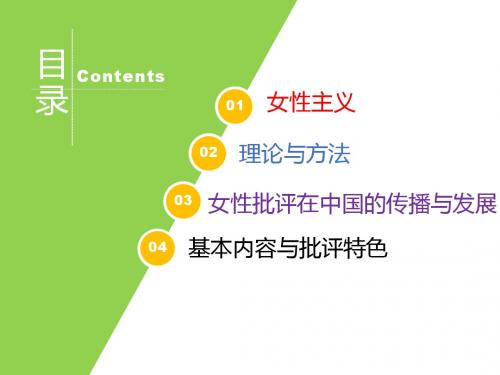
2、法国派:
兴起:20世纪60世纪末的结构思潮 两大理论来源:德里达的解构主义理论、拉康对佛洛伊德 精神分析理论的结构主义化 对语言及语义的生成变化表现出浓厚的兴趣,女性写作的 语言和文本是其研究的重热点 代表人物:埃莱娜.西苏《美杜莎的笑声》、《谈谈写作》, 茱莉亚.克里斯蒂娃《符号学》、《诗的语言革命》
目 Contents 录
02
01
女性主义
理论与方法
03
04
女性批评在中国的传播与发展
基本内容与批评特色
女性主义批评
女权主义批评是当代西方文艺理论之一。 女权主义文学批评诞生于 20 世纪 60 年代末 70 年代初的欧 美,至今仍在继续发展。
它是西方女权主义运动高涨并深入到文化、文学领域的成 果,因而有着比较鲜明的政治倾向。 它是以妇女为中心的批评,其研究对象包括妇女形象、女 性创作和女性阅读等。
3.理论的反思与视野的拓展(20世纪90年代中期以后作品中塑造的虚假女性形象和性别歧视内容 由此批判现实社会的男女不平等。 揭示父权制这一观念 二、对菲勒斯批评的批评
菲勒斯中心主义就是通过绝对地肯定男性的价值,从而维 持其社会特权的一种态度。
反思:现在的社会是否存在对女性的歧视?
女权主义批评在发展过程中广泛改造和吸收了在当代西方 影响很大的新马克思主义、精神分析、解构主义、新历史 主义等批评的思路与方法,体现了它的开放性,增强了它 对父权中心文化的颠覆性。
女权主义批评大体上分为英美派和法国派。此外,黑人和 女同性恋的女性批评,也以独特的内容丰富了女权主义批
理论与方法
女性主义批评的形成不仅有现实的社会和政治背景,也有 其文学理论、批评方面自身的思想渊源。 一、初现端倪 继承了妇女先驱者的理论创造。在20世纪前半期,英国的 伍尔夫和法国的波伏娃是备受瞩目的开拓者。
女性主义批评理论

女性主义批评理论)1 女性主义批评理论女性主义批评理论是一种重新审视文学体裁,特别是文学作品中作者对性别和性别关系的展现与内涵的研究手段。
它既属于社会理论,也属于专业文学研究,旨在发掘文学作品中男女概念的表达、叙事形式和潜在的性别偏见。
这种理论的起源可以追溯到十九世纪末、早期的二十世纪,以及1960年前后几位重要的文学家、女性主义者和女性学家的作品为基础。
女性主义者起初是希望社会本身实践性别平等,关注那些因性别不公而受到压制和忽视的女性,扩大女性的政治、社会和文化权利等;后来,随着女性主义的深入发展,女性主义批评理论就从而制定出来。
2 女权及其影响女性主义理论的核心思想包括争取社会性别平等、促进同性恋权利以及支持和抗议男性主流社会文化的权力等。
它的研究从性别的角度剖析作品,从性别角色与情感之间的关系出发,分析不同性别背景和文化状况下性别偏见如何干扰作品中人物形象的呈现,还有性别偏见如何反映在作品的结构和意义上。
3 电影领域的发展一些电影,特别是一些新的视角,从女性的角度出发,构建出一种新的视角去理解由本质上分裂开的女性和男性之间的关系。
同时,从摄影本身出发,采取不确定性的视角,将女性、男性、生活、性别等不同的维度综合起来,通过改写视角去理解生活、社会、家庭以及小范围社会之间的紧密联系。
此外,它还通过视角和美学形式表达出一种女性特有的态度、行动和价值观,诠释了女性发展的新路径,这是女性主义理论在电影领域的发展的重要变化之一。
4 总结随着女性社会的不断发展,女权作为一种新兴的理论获得越来越多的关注。
文学研究理论也根据女权理论而发展出一种女性主义批评理论,目的是在于以不同的视角揭示社会文明中的性别版图,揭示男女关系的新机遇,进一步平衡男女力量,是一种对文学的新的思考方式,对以后的文学研究起到一定的重要作用,也对文学作品的研究与批评有一定的指导意义。
女性主义批评方法

5、后结构女性主义文学批评 后结构主义对女性主义文学批评的影响在于语言观、“身 体书写”论以及解构文论。大多数女性主义者认为,由男 性操纵的语言表述与妇女的真实存在并没必然联系,因此 要颠覆现存的语言符号系统,改变语言结构,改变涉及她 们自身的语言用法,创造“妇女自己的语言”,进而倡导 “身体书写”。
2、精神分析女性主义文学批评 精神分析女性主义文学批评是受弗洛伊德与拉康 的精神分析学说影响而开创的新领域。一方面对 精神分析学说中的“阳物崇拜”发起猛烈攻击, 一方面又借鉴和运用精神分析学说的话语,作为 女性写作的指导原则,提出“女性话语”、“女 性写作”、“双性同体”的新概念。旨在把女性 从父权制话语的压抑下解放出来,营造女性“自 我认证”的大氛围。
女性主义批评概况
乔纳森· 卡勒:“女性主义批评这个名称应 该运用来批判所有关于性的压抑的批评流 派。” 阿里逊· 莱特:“女性主义批评家的任务是 披露‘性别歧视’,在每一个文学文本里 以不同的力量予以展示。” 女性主义文学批评是20世纪西方文性主义文学批评产生与理论发展
2、女性主义文学批评理论的发展 与形式主义、结构主义文学批评不同,女性主义 文学批评是一个凸现文学外部研究的批评流派。 它与20世纪以来的各种理论思潮有着千丝万缕的 联系,因而体系丰繁复杂。
女性主义文学批评的三个阶段: A“妇女形象批评” (women’s image criticism) B“妇女中心批评” (women-centered criticism) C“身份批评” (identity criticism)。
1、女性主义文学批评的兴起 女性主义批评源于妇女解放运动,重视对运动有 所助益的文学。这使女性主义批评成为一种社会 学色彩甚浓的文化批评。 科洛德尼指出,女性主义批评基本上是一种“怀 疑的”研究方法,她认为女性主义批评家的首要 任务是检验既往的美学判断的有效性:“这些判 断为什么目的服务?女性主义者问道;它们(即 使是无意地)帮助哪些关于世界的概念或思想态 度永久地存在?”
女性主义批评对文学的影响

女性主义批评对文学的影响女性主义批评是一种文学理论和分析方法,强调通过关注性别问题来解读文学作品。
它关注女性在社会、政治和文化领域中的地位和权利,并对传统男权社会中存在的性别偏见进行批判。
女性主义批评已经对文学研究产生了深远的影响,引发了重要的讨论和变革。
1. 背景女性主义批评起源于20世纪60年代的妇女解放运动,通过研究和反思传统男权制度对女性造成的不平等待遇以及对女性在文学创作和叙事中的边缘化问题。
该批评方法试图揭示并改变现有文学观念中存在的隐含偏见。
2. 文学分析方法2.1 叙事视角通过审视并分析作品中的叙述视角,女性主义批评者探索作者如何表达并塑造女性形象,并关注其是否存在刻板印象、陈旧观念或偏见。
他们尝试从女性视角去解读作品,探索其中潜在的意义和隐含信息。
2.2 人物角色研究女性主义批评者关注作品中的女性角色,并通过对其性别意识、职业选择和社会地位等因素的分析,揭示作品中存在的性别问题。
他们探讨女性角色是否被刻画为独立自主的个体,或者只是男性故事中的配角。
2.3 文本解读与历史背景联系女性主义批评也将文学作品置于其所处的历史背景中进行分析。
通过了解特定时代和社会对女性的限制和压迫,批评者揭示作品如何与这种限制相互作用,并在改变现状方面发挥积极影响。
3. 对文学理论和实践的影响3.1 数据收集与文学重启女性主义批评引发了大规模对忽视或 marginalize 女性作者和女性题材的文学进行重新发现和重新评估。
它推动了女性写作的复苏,并扩展了传统文学观点以包括更多种类的声音和经验。
3.2 其他形式的批判理论女性主义批评方法也影响到其他领域,例如种族理论(Intersectionality),后殖民主义批评以及性取向研究等。
这些理论方法重视在交叉性别和种族层面上对文学作品进行研究,传递更全面的信息。
3.3 文化认同和社会变革女性主义文学批评通过揭示女性在现实生活中面临的问题、挑战和抵抗,促进了社会对性别平等的关注,并为争取妇女权益和探索新的身份认同提供了框架。
中学文学课教学与女性主义批评

中学文学课教学与女性主义批评中学文学课教学是培养学生文化素养和人文精神的重要路径之一,而女性主义批评是文学批评的一个重要分支。
结合两者,不仅有助于学生对文学作品有更全面的了解,也能帮助学生进一步认识社会和自身的角色定位。
本文将从以下几个方面谈谈中学文学课教学与女性主义批评的关系。
一、女性主义批评的基础女性主义批评是在女性主义理论基础上发展起来的一种文学理论,其核心理念在于探寻、分析文学作品中存在的不平等关系和性别偏见,强调女性的主体性和发声权。
女性主义批评主张通过关注作品中的女性形象和性别关系来解析作品的意义,并且认为阐明性别偏见和表达女性真实体验是文学创作的重要目的。
二、中学文学教学应注意性别平等中学文学课教学中,应该引导学生关注女性形象和性别关系,唤起学生对于性别平等的关注和反思。
文学作品中的女性形象与性别关系,是社会文化和历史背景的反映。
在文学作品中,女性往往被描绘为弱势群体,往往缺乏自我意识和自我表达。
这种现象的存在,具有就社会、文化与历史的更深层次的反思意义,为了能更好地引导学生探究作品中存在的性别偏见和不平等,应该在中学文学课教学中融入相关知识,使学生能够更好地认识到在文学作品中表现出的性别歧视以及社会的不公平现象。
三、女性主义批评的重点女性主义批评的重点是表达女性的真实体验,在中学文学教学中,应该重点引导学生认识到女性体验的存在。
除了揭示性别歧视和性别关系中的问题,还应该鼓励学生从女性的角度出发去体验文学作品,了解作品中女性的真实情感,并将自己的生活与作品中女性的生活做一个对比。
通过这样的方式去理解女性主义批评,更有助于提升学生的情感认知和文学素养。
四、中学文学课教学要体现多元文化在中学文学课教学中,教师应该更注重多元文化,引导学生认识到不同文化、不同性别存在着差异性。
通过教授丰富的文学作品,给学生展示多样性、灵活性以及创造性。
让学生体会到在不同的文化背景中,作品所表达的核心思想、人性共同点和普遍性。
女性主义批评

7/21/2020
14
这祥,波伏娃就首次较系统地清算了男性作者的文学作品所 虚构的种种“女人的神话”,批评了他们对女性形象的歪曲 表现,严格说来,波伏娃的这种分析还只是静态的,但却为 后起的女权批评提供了极好的范例。
作为先行者,沃尔夫与波伏娃的思想中都还存在不少矛盾, 如沃尔夫对妇女作家作品中的性别意识较强略有微词,认为 这会损害文学的美学风格;波伏娃有时又用男性的学批评标 准来衡量、评价女性的文学作品;等等。但总的说来,她们 在思想观念和批评实践上,都为女权主义批评树立了榜样, 开辟了方向。
7/21/2020
3
第一节 女性主义批评方法的现实背景和思想先驱
一、现实背景
女性主义文学批评的催生物是西方妇女解放运动,两 者有着千丝万缕的联系,可以说没有妇女解放运动亦不可 能有女性主义文学批评的诞生,尤其是20世纪60年代后席 卷欧美的第二次女权运动直接引发了女权主义文学批评。
西方文明发展的历程中,男人作为社会的主宰,其人 性、政治地位、权力等方面无不得到了充分的发展和高扬, 而妇女则一直是被压抑的对象,在男人面前,女人一直是 劣等公民。追求个性解放和社会地位亦成为几百年来妇女 为之奋斗的理想、目标。妇女争取解放和自由的历程是与 人类争取自由、解放的历程共同向前发展的。
论妇女的生存状况,后被奉为“女权主义的宝典”。该书上卷
深入探讨了女性的生活、地位和种种神话,下卷主要说明当代
妇女从少到老的实际生活经历,研究她们的共同身心状况与生
存处境,提出:“一个女人之为女人,与其说是‘天生’的,不
如说是‘形成’的。女性意识的一部意义重大、对后世具有深
远影响的著作。波伏娃在她的这部理论著作中解构了女人之所
中,不仅广泛的生活经验之门对妇女关闭,而且法律和习俗 也严格限制了她们的感情生活,这是妇女创作难以发展的根 本原因。这种社会学批评,既抨击了男权中心社会对妇女创
- 1、下载文档前请自行甄别文档内容的完整性,平台不提供额外的编辑、内容补充、找答案等附加服务。
- 2、"仅部分预览"的文档,不可在线预览部分如存在完整性等问题,可反馈申请退款(可完整预览的文档不适用该条件!)。
- 3、如文档侵犯您的权益,请联系客服反馈,我们会尽快为您处理(人工客服工作时间:9:00-18:30)。
Ⅱ.Historical Overview and Major Themes in Feminist Criticism
• Elaine Showalter identified four models of difference: biological, linguistic, psychoanalytic, and cultural. The biological model is the most extreme; if the text somehow mirrors the body, this can reduce women merely to bodies. • Showalter’s linguistic model of difference posits women speaking men’s language as a foreign tongue; purging language of “sexism” is not going far enough.
Ⅲ.Four Significant Current Practices
• B. Marxist Feminism • Marxist feminist criticism focuses on the relation between reading and social realities. Certainly the establishment of feminist women’s studies programs, bookstores, libraries, political action committees, film boards, and community groups attests to the crucial connection between theory and reality offered by feminism. Unlike some other intellectual strategies, feminism acts on ideas.
Ⅲ.Four Significant Current Practices
• Feminist critics identify sex-related writing strategies, including matters of subject, vocabulary, syntax, style, imagery, narrative structure, characterization, and genre preference.
一、 定义
• 女性主义和女性主义文学并没有明确的存 在形式。和其它的批评方法不同,女性主 义文学批评通常是对其它批评和理论的政 治攻击。女性主义形式多样,关注所有女 性的边缘化问题。多数女性主义认为我们 的文化是父权文化:即以服务男性利益为 主导。女性文学批评家尝试解释在一个特 定的文化中,权力因性别失衡如何被反映 在文本中,或如何受到文本的挑战。
Ⅲ.Four Significant Current Practices
• A. Gender Studies
• Gender determines everything, some say, including language; as Elizabeth Abel has argued, “sexuality and textuality both depend on difference”.
二、女性主义批评的历史回顾和主 要议题
• 伊莱恩肖瓦尔特,美国领先的女性主义批 评家之一,确定了女性文学发展的三个历 史阶段:第一阶段,“女性化(feminine)” 阶段(1840至1880年),在此期间,女性 作家模仿优势传统;第二阶段,“女权主 义(feminist)”阶段( 1880至1920年), 在此期间,女性主张少数群体的权利并进 行抗议;第三阶段,“女性(female)” 阶段(1920至今),在此期间,反抗,即 揭示男性文本厌女症,被女性文本和女性 的重新发现所取代。
Ⅲ.Four Significant Current Practices
• A. 性别研究 • 有人说性别决定一切,包括语言;伊丽莎白· 阿贝 尔辩称:“性与文本性都依赖于差异化。” • 立志进行女性主义研究的男性经常是在性别研究 的总称下进行研究。在同性恋研究中,批评家通 常通过性别课题来研究这个对象。这两种人都对 男性和女性的某些特质比作者或读者的生物性别 更感兴趣。 • 女性主义批评家认同和性别有关的写作策略,包 括主题、词汇、语法、风格、意象、叙事结构、 人物和流派。
Ⅲ.Four Significant Current Practices
• Karl Marx argued that all historical and social developments are determined by forms of economic production. Marxist feminists attack the prevailing capitalistic system of the West, which they view as sexually as well as economically exploitative. Marxist feminists thus combine study of class with that of gender. In Marxists emphasize historical and economic contexts of literary discourse, they often direct attention toward the conditions of production of literary texts—that is, the economics of publishing and distributing texts.
Ⅲ.Four Significant Current Practices
• Male critics who wish to pursue feminist studies often do so under the umbrella term of gender studies, and in gay studies critics often approach their subject through the topic of gender. Both of these groups are less interested in a writer’s or reader’s biological sex than in certain qualities of masculinity and femininity.
Ⅱ.Historical Overview and Major Themes in Feminist Criticism
• Elaine Showalter, one of the leading feminist critics in the United States, has identified three historical phases of women’s literary development: the “feminine” phase (1840-80), during which women writers imitated the dominant tradition; the “feminist” phase (1880-1920), during which women advocated minority rights and protested; and the “female” phase (1920-present),during which dependency on opposition- that is, on uncovering misogyny in male texts-is being replaced by a rediscovery of women’s texts and women.
Ⅱ.Historical Overview and Major Themes in Feminist Criticism
• Showalter’s psychoanalytic model identified gender difference as the basic of the psyche, focusing on the relation of the gender to the artistic process. It stresses feminine difference as the free play of meaning outside the need for closure. Showalter’s most important contribution has been to describe the cultural model that places feminist concerns in social contexts, acknowledging class, racial, national, and historical difference and determinants among women over time and space-a “binding force”.
Feminist Approaches 女性主义批评方法
Ⅰ. Feminism and Feminist Literary Criticism: Definitions
• Feminism and feminist literary is absent rather than what is present. Unlike the other approaches we have, feminist literary criticism is often a political attack upon other modes of criticism and theory, and its social orientation moves beyond traditional literary criticism. In its diversity feminism is concerned with the marginalization of all women:
